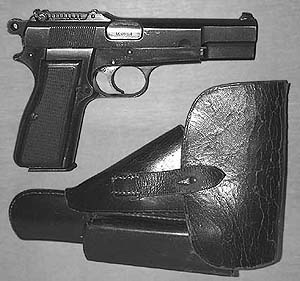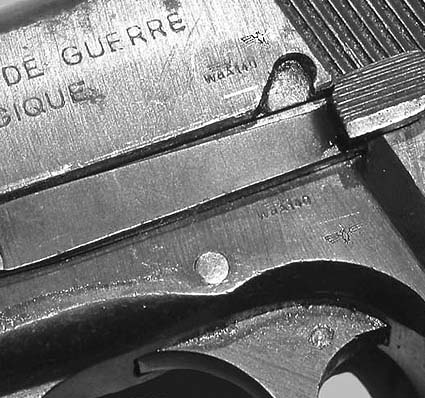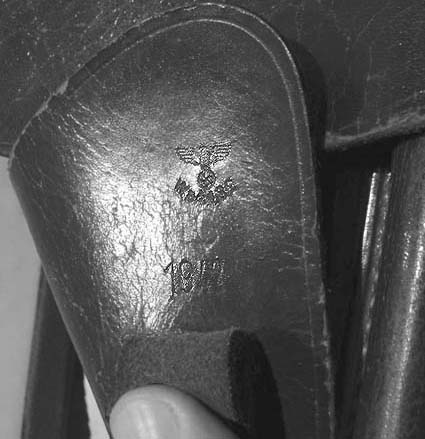The German Occupation Browning Hi-Power Pistol “Pistole 640(b)” |
||
from the collection of |
||
Dane Trembath |
||
On the 10th of May 1940, the German Wehrmacht invaded Luxembourg, the Netherlands, and Belgium as part of the overall invasion of France. This operation, codenamed Fall Gelb (Case Yellow), began with extensive air raids by both combat aircraft and Fallschirmjager (Paratroops) on airfields and other military installations, which severely disrupted the Belgian defenses. The Allied armies of Belgium, France, the Netherlands, and the United Kingdom attempted to halt the invasion by concentrating their forces in Belgium as they believed the main German forces would move there. Army Group B led by Generalfeldmarschall (General) Fedor von Bock engaged the Allied Forces, while sometime between the 11th and 12th of May the German Army Group A, led by General- feldmarschall Karl Rudolf Gerd von Rundsted made a decisive run through the Ardennes and reached the English Channel in five days therefore encircling the Allied armies. |
||
Through a series of bitter battles the Germans were able to reduce the Allied army size within the pocket and force them back to the sea. After 18 days of continuous warfare King Leopold III Léopold Philippe Charles Albert Meinrad Hubertus Marie Miguel sought an armistice with the German Army, thus ending a conflict which it is estimated claimed the lives of over 150,000 soldiers and an unknown number of civilians. On the 20th of May 1940 Mayor (Major) Wider, accompanied by the Leutants (Lieutenants) Rank and Terla, seized the Fabrique Nationale Plant in Liege. Upon seizure the following notice in German was placed on the front gate: “The entire F.N. Plant with all its installations and stocks is seized. The further manufacture of delivery on Thirds is only allowed with special permission of the Army Group”. Between June and July 1940 representatives of Mauser/Obendorf and Deutsche Waffen-und Munitionsfabriken (D.W.M) visited the factory and Dr. Franz Scharpinet of D.W.M. was placed in charge of getting the factory into production. As a result of the invasion most of the original technicians had disappeared so German technicians and labor were sent to operate the factory. Some of the former employees escaped to Britain with drawings and manu-facturing notes on the Browning High Power. In 1942 these drawings and notes were sent to Canada where the John Inglis Factory undertook production of this pistol for the Allies. |
||
Prior to the occupation the Fabrique National Factory had employed around 900 staff on salary with 10,000 workers. The Germans, through coerced labor and imported German technicians, increased the overall number to 12,000 staff. Production was slow at first with around 8,500 Browning Hi-Powers produced in 1940; however the following years saw a major increase in production (1941 – 65,700; 1942 – 80,600; 1943 – 101,200). By 1944 production was halted at 63,000 pistols due to the liberation of the factory by the Allied forces. Despite the German’s being pushed out of Belgium, Liege was subjected to aerial attacks of more than 1,500 V1 and V2 rockets from liberation until the end of the war. |
||
|
||
already existing parts in the factory as the Germans chose to eliminate this feature to save production time. There were three models produced under the German occupation. The early models with the slotted grip are marked WaA 613 indicating the Arms-Inspektor mark of Tennert and are in the serial number range of 44,500-65,200. From January 1941 till May 1942, the pistols produced retained the adjustable rear sight and are marked WaA 103 indicating the Inspektor mark of Lüttich and are in the serial range of 65,200 to 95,000. The last model produced are marked WaA 140 which is also the Arms-Inspektor mark of Lüttich. There are various examples of these that possess both the tangent rear sight and also a fixed rear sight. Serial numbers within the 95,000-135,000 appear to have the tangent rear sight whereas models after 150,000 have the rear fixed sight. At the beginning of 1943 an entirely new serial code number system was introduced: starting at 1a until number 99999a. This was started again in 1944 with 1b and continues to about 6300b when the Germans were pushed out of Belgium. |
||
|
||
into my collection, I immediately disassembled it using the instructions in Ian Skennerton's “9mm Browning Hi-Power Handbook”. After a few hours of cleaning, I was able to clearly see that it displayed WaA 140 indicating the last Waffenamt code used by Arms-Inspektor Lüttich at Fabrique Nationale. Additionally, the serial number in the 140,000 range indicates that this was from the last batch of adjustable rear sight models. This would probably indicate manufacture sometime during 1942, as the serial numbers changed in 1943. The magazine within the pistol bore the date of 1979; however one very rusty extra magazine proved to be an original Waffenamt magazine. While conducting |
||
|
||
ftc is the manufacturer code for Frost & Jähnel, Breslau 1, Schlossohle 7-9, who were a leather making business in Poland who manufactured holsters for the P.08 (Luger) and other handguns. |
||
|
||
with Waffenamt marked weapons or militaria to take the time to research them as you might be able to reliably date them as I have been able to do with my pistol and holster. |
||
Literature Cited |
||
Miller, D. (2001). The Illustrated Directory of 20th Century Guns. Salamander Books. London, England. |
||
Skennerton, D. (2005). 9mm Browning High Power Handbook. Ray Riling Arms Books, Philadelphia, PA, USA. |
||
Walter, J. (2005). German Military Letter Codes: 1939-1945. Tharston Press, Godstone, Surrey, England. |
||
Whit, J. (2011). Able Item Four Fox Roger Homepage. (Accessed March 2011) |
||
http://www.ai4fr.com/main/page_militaria__collectibles_germany_hipower.html |
||
Whittington, R.D. (2005). German Pistols and Holsters: 1939/1945: Military – Police –NSDAP 6th Edition. Ray Riling Arms Books, Philadelphia, PA, USA. |
||


